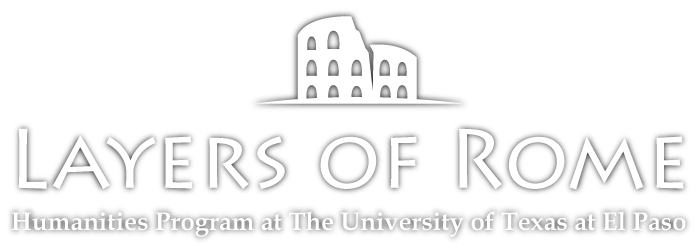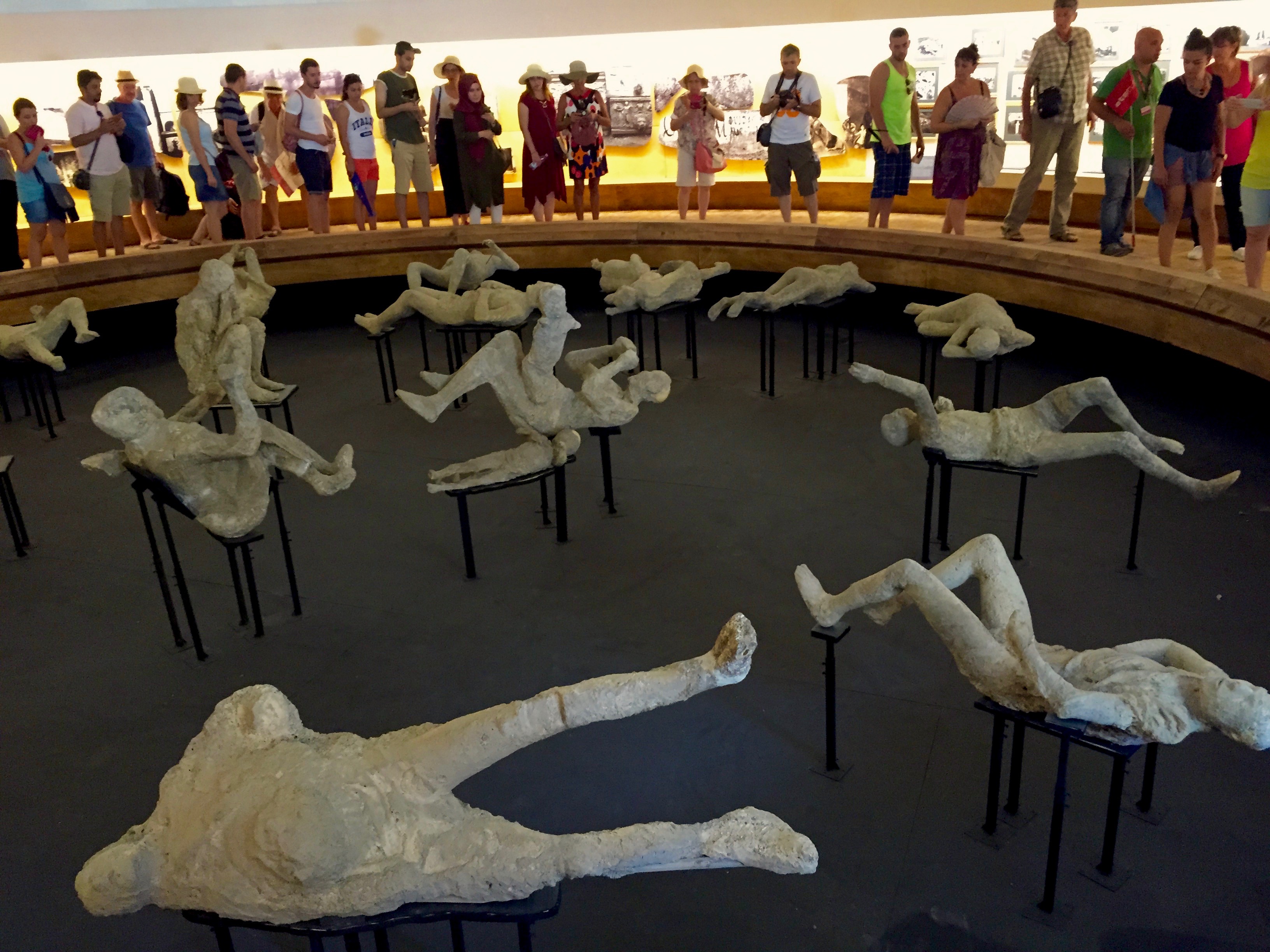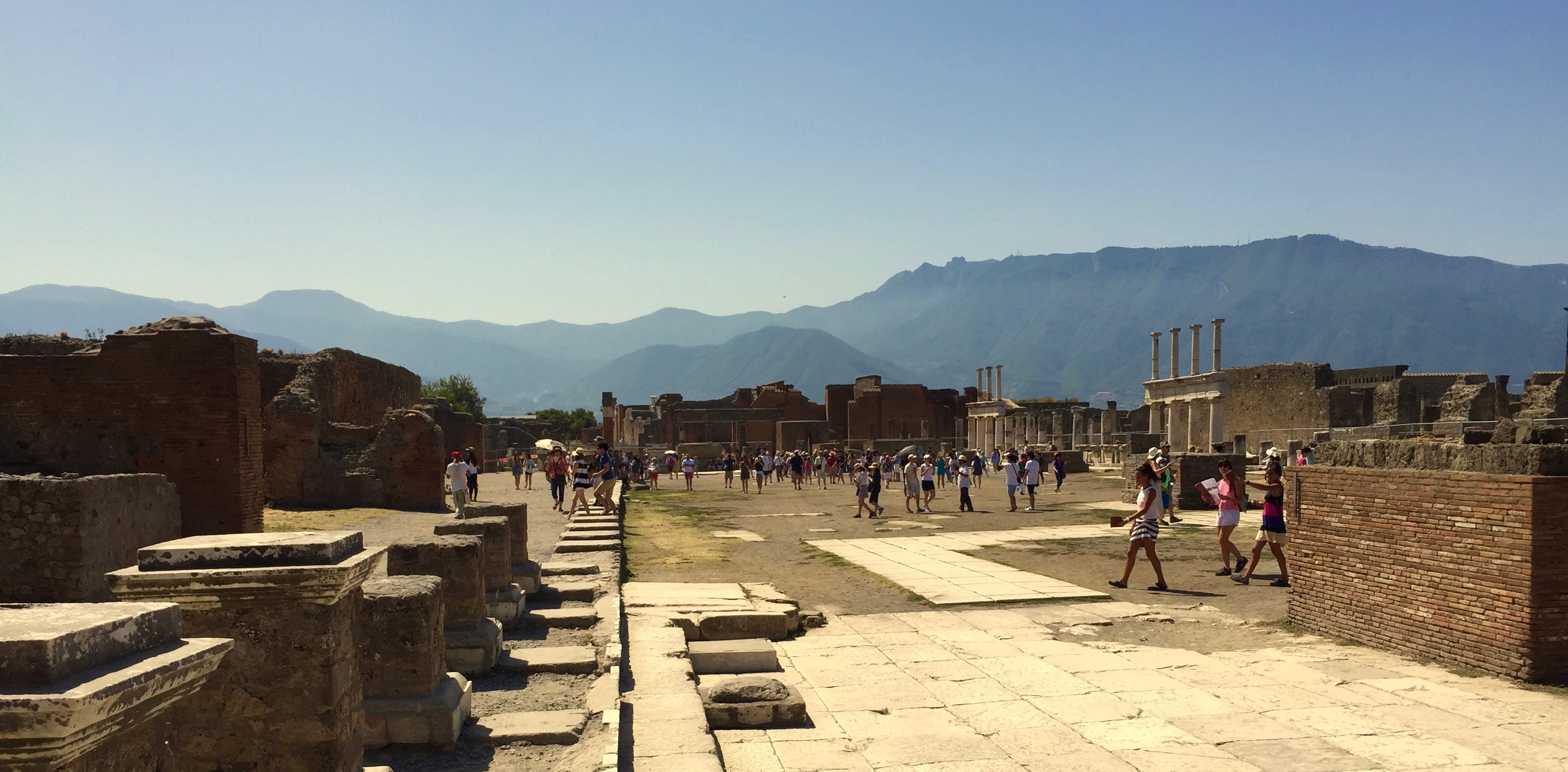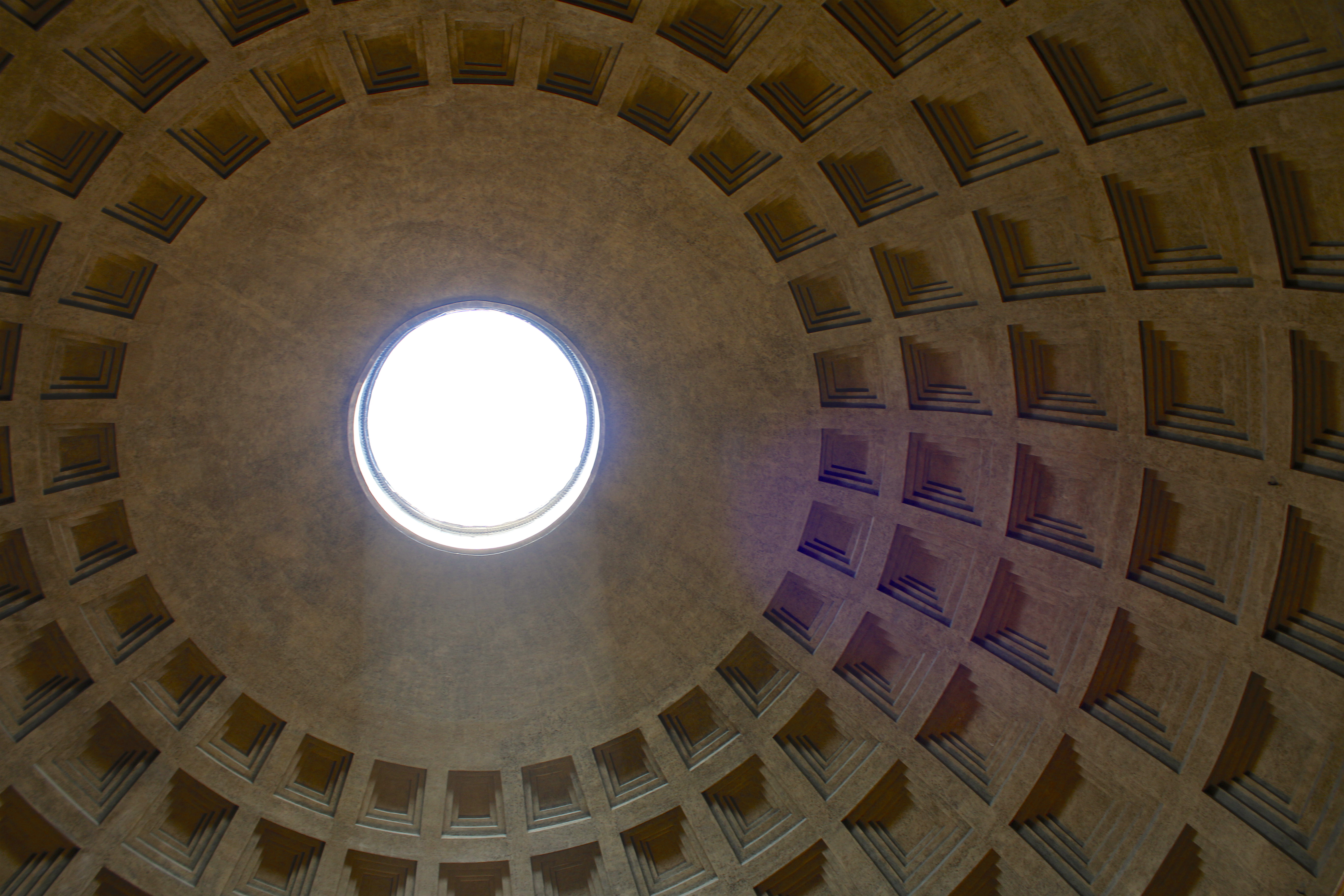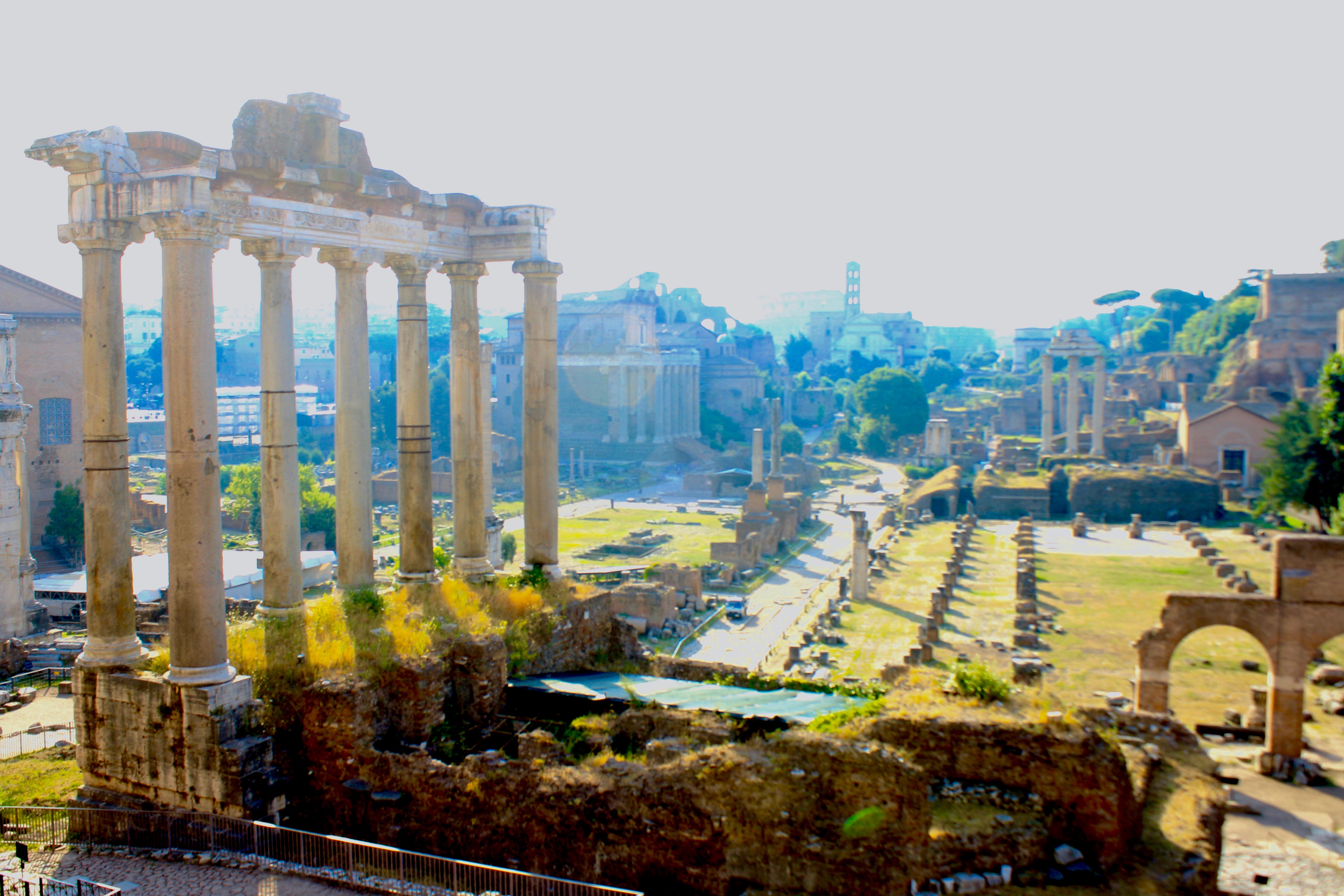Grade Levels: K-4
Time Required: 4-6 class periods
Author: Melody Nishinaga
Subject Areas: History, Music, English
This lesson was designed as a continuation of the lesson entitled Continuity of Culture: Romans in Pompeii. http://layersofrome.utep.edu/lesson-plans/20-romans-pompeii
In this lesson students will act as musical archaeologists. They will study and analyze remnants of ancient Roman civilization and its music, the instruments used to perform it, the structures such as the Odeon and the music theaters where it was produced, and the mosaics, frescos and sculptures which depict how it was played.
In this lesson, by taking a closer look at surviving musical artifacts and art works such as those from Pompeii, students will gain a broad appreciation of music as performed in the past. They will study how the ancient Romans in Pompeii in their production and appreciation of music are similar to people today. By comparing reconstructions of ancient Roman music with their own, students will be able to draw parallels between the two. Ultimately, they will use the remnants and the comparisons to attempt to reconstruct the musical environment of ancient Rome.
The absence of recording technology in the Roman period has left us with a great deal of uncertainty about the sound of Roman music. However, Roman literature and art provide significant information about how the Romans produced music, and archaeologists have uncovered many different types of musical instruments, which musicians have attempted to reproduce. Representations abound of musical performances at funerals and in religious rituals. Music featured prominently in social situations as well. Roman poets such as Horace and Quintilian composed poetic pieces known as odes that were performed on civic occasions, and the rhythmic patterns of the Latin language in this poetry provide us with clues to the nature of Roman music even though we lack melodic accompaniment. Because the Romans admired and imitated so much of Greek art, modern scholars assume that Roman musicians were influenced by Greek musical theories, and therefore they composed works that were most often single melodies with no harmony. It is clear, however, that the Greeks were not the only influence in Roman music and that Etruscan, Middle Eastern and African elements were also prominent in Roman music. How these sounds combined is a matter of conjecture.
Throughout the ancient world, music was seen as a powerful medium with the strength to affect the human soul. In the Bible it was the blast of trumpets that brought down the walls of Jericho, and David cured Saul’s madness by playing the harp. Plato argued that music was such a strong force of persuasion that it should be regulated by law. As Pythagoras explained it, the measured tones of music embodied the harmony of the cosmos. Audible tones exemplified the principles of order common to the harmony in the systems of the physical world, the human body, and the human soul. As a result, music to the ancients was not a passive symbol of the orderly cosmic system; it was a force that could affect the universe and the populations within it. Aristotle asserted that listening to a type of music over time caused a person’s character to be shaped by it. This occurred because in Aristotle’s mind music directly imitated the passions of the human psyche.
With the rise of Christianity in the later Roman Empire, belief in the force of music and its association with pagan rituals resulted in the suppression of Roman music. Consequently, in the medieval period musical production shifted to the Christian Church and the remnants of Roman music were either destroyed or lost. Today nearly all knowledge of musical performance in the ancient world is second hand, derived from a few vague accounts of performances and theoretical works. By combining the documentary evidence with the archaeological remains of instruments and visual representations, students in this lesson will attempt to replicate some of the sounds of Roman music.
*Do the architectural plans and the remains of Roman odeons, theaters and concert halls resemble modern performance buildings?
*Do the events that take place in modern performance venues resemble ancient musical events?
*In ancient paintings, mosaics and sculptures, in what contexts are musical instruments used?
*Do the ancient musical instruments in the artistic representations resemble modern instruments?
*Based on the ancient artistic representations, is it possible to discover how ancient instruments worked?
*Based on the surviving evidence, how can we recreate the music of the ancient Romans?
1. Students will use methods of social science investigations to answer questions about society.
2. Students will use knowledge of the past to construct meaningful understanding of our diverse cultural heritage.
3. Students will know and apply grade-level word analysis in decoding words.
4. Students will read with sufficient accuracy and fluency to support comprehension.
5. Students will conduct short research projects that build knowledge about a topic.
6. Students will write an expository text or poem to convey the similarities between Romans and us.
7. Students will use primary and secondary sources to answer questions about the past.
8. Students will understand basic sound properties, such as longer tubes produce lower sounds and shorter tubes produce higher sounds.
1. Teach lesson Continuity of Culture: Romans in Pompeii. http://layersofrome.utep.edu/lesson-plans/20-romans-pompei
2. Download the power point presentation, “Ancient Roman Music Primary Sources” containing pictures of ancient Roman theaters and musical artifacts from Pompeii, which are now in the National Archaeological Museum of Naples. This power point is included in these materials. Need to be uploaded and link established.
3. Obtain a book of children’s literature that describes how archaeologists are essentially detectives, who piece together the clues that they find and then recreate what they think happened in history. For example, a book such as Nancy Drew: The Hidden Window Mystery or The Boxcar Children or Archaeologists Dig for Clues by Kate Duke.
4. Obtain a book on the Greek god Pan such as I am Pan! by Mordicai Gerstein. The panpipe was an instrument depicted in many primary sources, such as mosaics, frescos, and statues.
5. Collect materials to build pan-pipe instrument:
- Glue / sticky tape
- Plastic straws (8 straws per child)
- Scissors
6. Construct a replica of a panpipe:
- Lay 8 straws side by side.
- Cut the first straw at 20cm.
- Then cut the next straw 2cm shorter, at 18cm.
- Cut each straw 2cm shorter than the last until all 8 are cut.
- Line up your straws longest to shortest. Make sure the flat end is completely aligned.
- Sticky tape them together.
- Blow across the flat end of the straws, at an angle and at a distance to get the best sound. The longest straws will give the lowest sound, and the shortest straw will give the highest sound.
7. For background information on Music in Ancient Rome, obtain a book such as Music in Ancient Greece and Rome by John G Landeis.
8. Collect music CDs by Synaulia https://www.youtube.com/watch?v=uJLXyBzMci0 and Soundcenter.it http://www.soundcenter.it/synauliaeng.htm and Musica Romana, http://www.musica-romana.de to hear how these musical archaeologists recreate Roman music.
9. Have students gather tambourines, hand drums, and recorders for use in the production of a musical performance imitating ancient music. See Additional Lessons and Resources for examples of recreations of ancient music.
10. Download Graphic Organizer http://layersofrome.utep.edu/images/Graphic_Organizer_.pdf
11. Download Lesson Overview: http://layersofrome.utep.edu/images/Lesson_Overview2.pdf
Lesson One: Play the Telephone game. Have all students line up. There are 21 students in this example, but each teacher should adjust for their class size. Teacher should explain to the class that she/he will whisper a phrase to the student next to her/him, explaining that each student can only whisper the phrase once to their neighbor. Sample phrase: Goofy gophers gobble green gigantic grapes and love them! (Adjust according to age). At the end, the phrase should have become something different. Explain that each student represents 100 years of time. Ask the first student to say what year it is now, and count backwards by 100 until they reach the year closest to 79 AD, the eruption of Vesuvius.
2015 – 1915 – 1815 – 1715 – 1615 – 1515 – 1415 – 1315 - 1215
– 1115
1015 – 915 – 815 – 715 – 615 – 515 – 415 - 315 – 215 - 115
Explain that messages change over time. Objects get lost or destroyed. Messages may change when passed down over hundreds and hundreds of years. Explain that like musical archaeologists it is important to us to look at what still survives of the time (primary sources) and try to piece together the puzzles and try to draw more accurate conclusions about music at Pompeii.
Read Archaeologists Dig for Clues by Kate Duke.
Lesson Two: Project images from Pompeii and the Naples national museum. Suggested images are included in the power point presentation “Ancient Roman Music Primary Sources.” Start with the Odeon, and ask students what modern structure it looks like, for example a movie theater or concert hall. Explain that the Odeon was designed for musical events.
However, music was not only played in concert halls. It also occurred in many other places. Project images of mosaics and frescos depicting scenes where music occurred:
- Ask students to identify: Where the ancient musical scenes were happening: ie Church-like place, party, someone’s house, etc.?
- What do the instruments in the ancient scenes look like? (Have students mention instruments that they know, like a flute or an organ).
- The ancient scenes often contain multiple instruments. What are the different instruments that are pictured playing music together?
In addition to the musicians, what other types of people are shown in the ancient scenes: ie actors with masks?
Lesson Three: Project images of sculptures holding musical instruments and surviving instruments. See the power point presentation “Ancient Roman Music Primary Sources.” This power point is included in these materials. Need to be uploaded and link established. Explain that archaeologists study each clue in detail. What stories does each object tell us?
- Ask students to describe what each instrument looks like and what modern instrument it resembles? (Have students describe instruments that they know, like a flute or an organ).
- Ask students to describe what the ancient instruments sound like. (Draw from their knowledge of modern instrument sounds).
Focus on one instrument that is depicted often in the ancient art, the panpipe. Have students read the story about the god Pan to provide students with information about this god.
Read I am Pan! by Mordicai Gerstein.
Have students create a panpipe based on primary sources. (See the instructions in “Preparation Instructions.”) Explain that archaeologists recreate ancient musical instruments based on what they see in ancient art.
Lesson Four: Discuss the science behind creating sound with boom whackers to show that shorter lengths of tubes create higher pitches, and longer lengths of tubes create lower pitches.
http://www.teachertube.com/video/teaching-sound-with-boomwhackers-125733.
Lesson Five: Talk about how musical archaeologists do what the class has just done. Play recordings and project images of musical instruments and/or play videos of performances. (See “Additional Lessons and Resources” for video suggestions.)
Lesson Six: Coordinate a musical performance, with tambourines, hand-drums, recorders, and panpipes.
If students play recorders, have them bring them. Teach the class a simple song, and coordinate a musical production, with tambourines, hand drums, recorders, and panpipes. (See “Additional Lessons and Resources” for audio and video suggestions.
(Extending over a few days) Students write and revise papers or poems on the similarities between how the Romans created music and modern musical performances. Note: Young children would draw pictures of instruments identifying the similarities.
Complete a Venn diagram to compare and contrast Roman music with music today.
Students can use a Graphic Organizer to identify different musical instruments, pictures of ancient musical instruments or different ancient performance venues and describe how they resemble the artifacts and buildings used for modern musical productions. http://layersofrome.utep.edu/images/Graphic_Organizer_.pdf
Stress the interdisciplinary nature of music.
Science / Math
Focus on the ancient theaters and odeons and discuss their acoustics. To investigate the physical science of sound waves, fill several glasses with different levels of water. Put food coloring in each glass for easier identification. Glasses with more water will create a lower sound when tapped. Glasses with less water will create a higher sound when tapped. Include the glasses in the musical performance.
Art / Theater / Music
Recreate a performance as seen in an ancient mosaic or painting. Students can participate by designing and creating costumes or writing a script about a day in the life of musicians at Pompeii or making instruments.
Language Arts
Have students share their knowledge with the world by producing their own newspaper, the Pompeii Times. Students can write articles about what they discovered about Rome and Roman music.
Have students write their own fictional short story based on a piece of ancient artwork.
Reading:
CCSS.ELA-Literacy.RI.3-6
Determine the meaning of general academic and domain-specific words or phrases in a text relevant to a grade 3-6 topic or subject area.
CCSS.ELA-Literacy.RI.3-6
Interpret information presented visually, orally, or quantitatively (e.g., in charts, graphs, diagrams, time lines, animations, or interactive elements on Web pages) and explain how the information contributes to an understanding of the text in which it appears.
CCSS.ELA-Literacy.RI.3-6
Read and comprehend informational texts, including history/social studies, science, and technical texts, in the grades 3-6 text complexity band proficiently, with scaffolding as needed at the high end of the range.
Writing:
CCSS.ELA-Literacy.W.3-6
Write informative/explanatory texts to examine a topic and convey ideas, concepts, and information through the selection, organization, and analysis of relevant content.
CCSS.ELA-Literacy.W.3-6
Conduct short research projects to answer a question, drawing on several sources and refocusing the inquiry when appropriate.
Download: Lesson Overview http://layersofrome.utep.edu/images/Lesson_Overview2.pdf
Books:
Nancy Drew: The Hidden Window Mystery by Carolyn Keene.
The Boxcar Children by Gertrude Chandler Warner and L. Kate Deal
Archaeologists Dig for Clues by Kate Duke describes a group of friends who accompany an archaeologist on a dig and learn all about what archaeologists do and how discoveries tell us how people used to live. (Grades 1 – 4) ISBN-13: 978-0064451758
Music in Ancient Greece and Rome by John G Landeis ISBN-13: 978-0415248433
A History of Western Music by Donald Jay Grout: W.W. Norton & Company, New York, 1960
The Archaeomusicology of the Ancient Near East, by Richard Dumbrill, Trafford Publishing. London, 2005.
Videos:
Musica Romana: http://www.musica-romana.de/
Synaulia: https://www.youtube.com/watch?v=uJLXyBzMci0
Soundcenter.it: http://www.soundcenter.it/synauliaeng.htm
Ancient Greek Musical Instruments Ensemble: https://www.youtube.com/watch?v=b4jx2-QJ5ss
Seikilos Epitaph – Song of Seikilos – (Reconstructed Ancient Greek Song): https://www.youtube.com/watch?v=BVYSrEuTP5A
Listen to the “Accurate” Reconstruction of Ancient Greek Music with the World’s Oldest Known Complete Song: https://www.realmofhistory.com/2016/09/03/accurate-reconstruction-ancient-greek-music/
The Oldest Known Melody (Hurrian Hymn no. 6 – c. 1400 B.C.): https://www.youtube.com/watch?v=QpxN2VXPMLc
